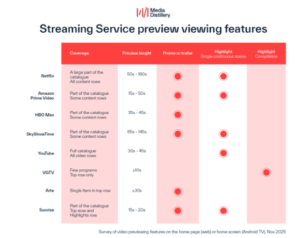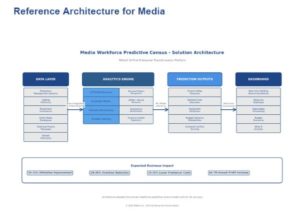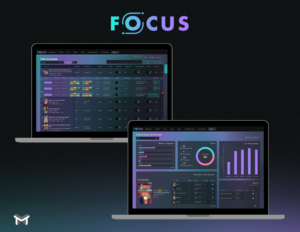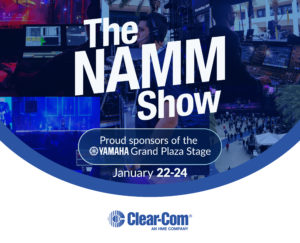September 2024
MediaTech Radar is a monthly newsletter put together by IABM’s Business Intelligence Unit. It focuses on a spotlight topic in MediaTech and reflects on a series of past, present, and future business developments in the industry. In this edition, our spotlight topic is IBC2024 Show, which was attended by over 45,000 MediaTech industry stakeholders and enthusiasts – the number being up by over 2,000 year-on-year, according to IBC. A rapidly changing competitive landscape, customer priorities and technology upgrades and innovations are discussed below.
MediaTech Spotlight: Key takeaways and tech highlights at IBC2024
- Competitive landscape: Driven by media technology buyers’ focus on cost, efficiency and flexibility, MediaTech vendors see that their competitive landscape is changing with smaller, formerly unknown tech start-ups entering the market and claiming a place in premium, large-scale projects. The move to the cloud is enabling media businesses to experiment, innovate and co-develop solutions together with public cloud service providers. Open-source technologies and DevOps culture are democratizing software development, benefitting small tech start-ups forming partnerships with customers and focusing on one specific application. For example, the proliferation of low-cost, easy-to-use software for running pre-optimized LLM models locally on a user device is opening up access to AI for smaller businesses. As media companies are becoming more software-driven, the role of cloud-based microservices – which are increasingly being used to bridge different supplier interfaces together – is becoming more important, allowing media businesses to rapidly build up new futureproof environments and scale them out together with small vendors, intensifying competition in the M&E space.
- Hybrid cloud: In line with IABM data, discussions at the show confirmed that while there is a slowdown in investment in cloud services and workflows among media companies, hybrid cloud is widely seen as the best way forward when trying to find the right balance between cost and reliability. Media companies are looking at lower tier storage solutions as well as increasingly breaking down their overall infrastructure cost to understand their total cost of ownership (TCO) – this is a major pain point for many media businesses.
- Efficiency: Being laser-focused on cost and doing “more with less” is driving media businesses’ investments in efficiency, flexibility and scale – the ability to schedule and automate the provisioning of resources at peak times. ARM-based computing is emerging in customer conversations related to efficiency and AI, the latter currently requiring a lot of computing power. Media companies – moving towards cloud/SaaS and trying to simplify their supply chains – are increasingly basing their tech decision-making on platform efficiency and TCO. A major public cloud service provider explained: “Our customers are coming to us more for the power of cloud computation and the flexibility and scalability to pay for what they use. In live cloud production, we get to the point where the cloud infrastructure to produce a major sports game costs less for our customers than the hotel room for one of their employees. This is something that many of our customers are very excited about.”
- Sustainability: IBC Accelerator Programme Ecoflow – composed of Accedo, Humans Not Robots, BBC, ITV and the Greening of Streaming – showcased for the first time how energy consumption of streaming on a consumer device can be measured by a plug-in smart meter attached to an OLED TV. Ecoflow’s software could then be used to make smart decisions to optimize their experience whilst taking into account their energy consumption – for example adjusting their brightness level, turning off HDR or using only the audio. The significant drop in energy consumption after selecting a combination of Ecoflow features is promising, paving the way for the further development of energy measurement systems at the consumer end.
- AI: Although AI is still in a stage of infancy, it continues to be a heated topic of debate for the industry as MediaTech companies evaluate how they can put it to best use in their product portfolio and utilize it at an operational level in their own organization. Media businesses are simultaneously experimenting with different public cloud service providers’ AI solutions, offering a cost-effective way to test how AI can be used in different parts of the media supply chain (e.g. informing and coaching storytelling effectively). The high cost of AI remains a major concern for media companies, making them somewhat reluctant to run AI inside their own infrastructure. At the same time, GenAI is gradually democratizing AI technology with new application-specific solutions being increasingly developed by small players in the market. A large MediaTech vendor said: “There’s so much flux in the marketplace. We make one of the flagship GPU servers that are used for AI training by hyperscalers, but it’s also in a smaller scale, where a VFX company might have a single DevOps person working away on a sandbox workstation and nobody knows what tool that person will come up with, but when it hits and goes through POC and becomes a real production tool, we have the infrastructure to scale that up rapidly.”
- Democratization: MediaTech vendors are increasingly looking at addressable markets in “non-traditional” verticals such as corporate, medical and education sectors. While M&E remains the most important customer segment, many suppliers say that their sales to adjacent markets are growing consistently. One MediaTech supplier said: “Actually, the whole cloud journey kicked off for us with TUI, which is one of the biggest travel agencies in the world. They recently had this internal project called TUI to Cloud. We had to bring their offices all over the Europe to a centralized cloud platform. TUI was already working with AWS, because they do a lot of content production for TV, brochures and cruises. They approached us to do that and now we have a product that is live since few months.”
MediaTech Watchlist: AWS, Nvidia, Panasonic, BBC
- In Q2 2024, AWS told the UK Competition and Markets Authority (CMA) during a hearing of its Cloud Services Market Investigation (focusing on anticompetitive behavior in the UK’s cloud service market) that its cloud business faces competition from on-prem infrastructure providers and that an increasing number of customers are switching certain applications back to on-prem within a hybrid cloud framework to better manage costs. However, in the long term, the majority of end-users in M&E are still choosing to use public cloud, while doing so with a more considered approach and migrating their operations on a workflow-by-workflow basis. AWS also mentioned that in the field of AI – where the competition has become “incredibly fierce” over the past six months – there is more competition for accelerated compute particularly from completely new players, not just from Google and Microsoft. AWS told the CMA that some customers are already investing in accelerated compute (e.g. ARM-based computing) directly. This is in line with IABM data and will be discussed in more detail in the upcoming TechTracker report.
- In mid-September, Panasonic announced that it will extend NDI (Network Device Interface) support to its 4K Integrated PTZ Cameras, making the upgrade available in over 80,000 units through a free firmware update in Q1 2025. Enabling NDI – an open IP standard – in PTZ cameras not only increases the installed base of NDI devices out in the field, but also improves the streaming quality with lower latency as these cameras will be able to use advanced video compression. Panasonic’s upgrade demonstrates the gradual democratization of MediaTech, driven by the move to IP bridging the gap between professional and non-professional productions and providing the creator community and tech buyers in adjacent markets with more flexible, efficient and affordable equipment.
- In late September, Ateme – a supplier of video delivery solutions – announced collaboration with Nvidia to deploy its Tital video processing and compression solution with Nvidia Holoscan for Media, an AI-powered live media platform. The collaboration aims at reducing media businesses’ operational costs through AI-powered optimization of resources, efficiency and all IP-infrastructure. Dell is working with Nvidia Holoscan as well, enabling access to all Nvidia’s AI microservices (NIMs), helping developers to build and deploy Gen AI applications more easily. At IBC2024, Pebble also showcased support for Nvidia Holoscan with its Prima platform. Daniel Robinson, Head of Product at Pebble said: “By integrating Prima with Nvidia Holoscan for Media, we can now deliver those highly efficient, high-performance media environments on shared compute platforms, helping drive down costs and achieve greater sustainability.”
Thank you for reading this newsletter. If there are topics you would like us to cover or if you have information/ideas that you would like to share, please get in touch with us.
The IABM Business Intelligence Unit









